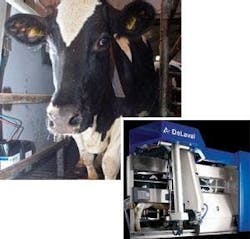Automated milking systems have become de rigeur for many modern-day dairy farmers; the first robotic milker was introduced in The Netherlands in 1992, and today the technology is used regularly by farms and dairy businesses worldwide to streamline the milk-gathering process, increase yields, and improve milk quality. A 122-year-old Swedish dairy-equipment company offers what many consider the Cadillac (Volvo?) of automatic milking systems, incorporating the latest in Doppler-laser-based vision systems, RFID and tracking technologies, and robotics to offer dairy cows a kinder, gentler—but definitely high-tech—milking experience (for video confirmation, see https://youtu.be/aPqWpOxQmIs).
In essence, the DeLaval (www.delaval.com) Voluntary Milking System (VMS) puts the cows in charge of their own milking schedule. Each cow is outfitted with an RFID collar that is scanned when she first enters the milking shed, providing the VMS with information about expected output, flow rates, and feed and medical requirements. The cow then enters a milking stall, and gates lower over her neck and behind her to keep her in place (see figure). To ensure that the cows remain calm, cool, and collected during the milking process, feed is provided, complete with medication and nutritional supplements.
Once the cow is settled in, the VMS robotic arm swings into action. The cow’s udder and teats are washed with an antiseptic cleanser and air-dried. Utilizing what DeLaval calls a “high-performance teat-visualization system” that uses two lasers and a solid-state camera to aid in proper positioning, a robotic arm moves the teat milking cups into place. Once secured, the VMS purrs into action and the cow can nosh, snooze, or daydream away the six to eight minutes it takes to complete the milking process. Four optical milk meters monitor deviations and abnormalities in flow rates, yields, conductivity, and blood levels. Each cow is milked according to its expected output, then washed and dried again before being released back out to pasture.
While DeLaval is the market leader in automated milking systems, with some 1000 installed systems in Europe, Canada, Japan, and Mexico, and 50% market share, very few of the voluntary milking systems are in use in the United States. But last November a small farm in Pennsylvania became DeLaval’s latest satisfied customer. Thanks to the efforts of son Josiah Garber, who had hesitated returning to work on the family farm after finishing college, in part because of the long hours, Spring Lawn Farm is now the proud owner of the first VMS system in Lancaster County. In addition to making the milking process nicer for cows and increasing milk yield and revenues, the VMS also eases the day-to-day burden on farmers like Garber by eliminating the need for 4 a.m. wakeup calls and repeated visits to the milking barn.
“The quality of life issue is big for me,” Garber told the newspaper Lancaster Farming last December (see www.lancasterfarming.com). “There are too many hours required to milk cows.”
Sometimes all it takes is a little forward-thinking to usher in a new era.
About the Author
Kathy Kincade
Contributing Editor
Kathy Kincade is the founding editor of BioOptics World and a veteran reporter on optical technologies for biomedicine. She also served as the editor-in-chief of DrBicuspid.com, a web portal for dental professionals.
